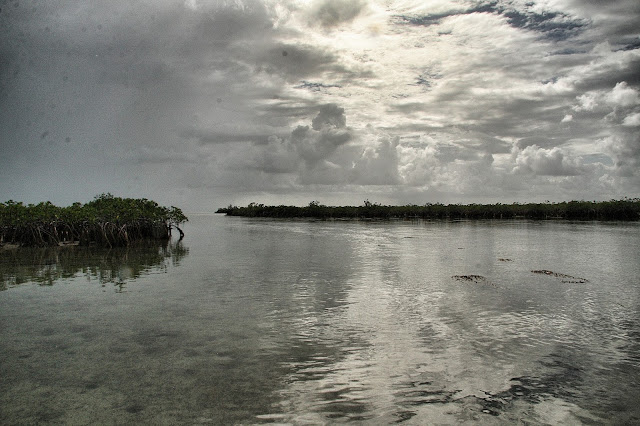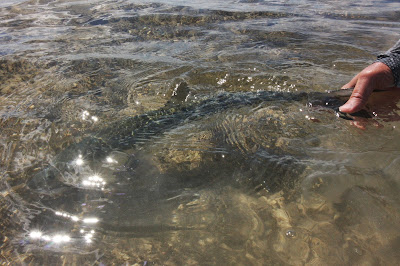We had yet another great trip this October to Water Cay Lodge on Grand Bahama Island! We experienced some sunny days, some cloudy days, some windy days and some rainy days. We caught some fish and didn't seal-the-deal on many others. We made some good casts and failed miserably on others. We spotted fish well and couldn't see others right in front of our skiff. We laughed, played poker, enjoyed the beauty of Water Cay and came home happy!
...just what you would hope for when planning a bonefish trip to theBahamas!
Instead of giving a traditional, day by day fishing report, I'm going to jump all over the place to hopefully give you the flavor of our adventure this year!
Let's start with why we go to Water Cay... the great shots at shallow water/tailing fish and the superb guides who teach us so much year after year...
We were spinning doughnuts on a massive flat that spanned a slender sickle shaped cay. Surrounding us were thousands of bonefish chews. Some were old, many were very new. We could tell some were very fresh by their color, a light charcoal, and were made on this morning's falling tide as the debris was deposited on the ocean side. If made on last night's rising tide they would have pointed inland towards the cay. Many of these feedmarks were still smoldering. These fresh "smokes" both clouded the water and made locating the perpetrators harder. As we searched, we spun in circles. ...a smoking chew there... a cloudy puff over there. But where were the fish?
“11 o'clock, tail 100 feet coming out of that small bay. "Left side”, Sid whispered.
"Put your fly on the outside and we’ll wait for him to come out...” then Sid added, “He’ll have to come out soon.”
“Wait! Let him roll up on your fly.” Sid added soon.
“Short strip... Stop”. Sid instructed.
The fish charged the fly.
Dan followed orders, then slowly lifted his rod as the big tailer bolted for deeper water. Dan reeled hard making up some of the backing that had peeled off his reel.
“Rod right and tighten your drag... there’s a shark after him.” Sid said obviously frustrated. It was the only shark we had seen all morning.
Dan spun his drag down then pulled hard. As he was making some headway, his line stopped. He lifted his rod tip and pulled up a bunch of bubble grass that had obviously unhooked his bonefish.
"That shark is chasing the bone. Maybe I can scare him away." Sid said as he poled hard towards the commotion.
“Naaawww!” Sid muttered as a red spot flared on the flat. "He got him!”
We went over picked up the bonefish. His tail had been neatly removed leaving an arc shaped wound.
Sid took the fish and put him in the boat. Waste not want not. This fish would be someones dinner tonight. Sid poked the shark with his pole. The shark was excitedly was looking for the rest of his meal. The shark jetted off hopefully appropriately schooled.
Although this bonefishing chapter ended with disappointment (more so for the fish than the fisherman), it perfectly illustrates the finely refined technique the Water Cay guides use.
I'll give explaining it a stab...
There are four basic commands:
The term strip is used after the fly hits the water to pull the fly into the fishes window or path. It is a positioning move only.
Short strip or bump moves the fly a short way and is used to entice the fish to eat. It is only done once, unless the fish does not see the bump, then it is repeated ONCE!
Stop means just that. Do not move the fly at all... the fish is going to eat the fly.
Long slow strip means the fish has eaten the fly. It is basically a strip strike, but if executed properly, it keeps the fly in the bone’s wheelhouse and, if not eaten, gives you a second chance.
With this technique, there is no strip, strip strip commonly heard from less experienced bonefish guides. It’s strip, stop, short strip, long slow strip... then all hell breaks loose as another big Water Cay bone barrels off towards Florida.


The Water Cay guides are some of the most technically oriented guides in the Bahamas. They are constantly fine tuning their craft. For instance, after you have casted and you are making the initial strip, they want you to have your fly rod tip down at water level. This is because when they tell you to execute your short strip or bump they don’t want the weight of the fly line (created by any gap between fly rod tip and water) to pull the fly out of the fishes window after he tips up to eat. This small movement of the fly can necessitate the need to “bump” the fly again which will cause the bone to reposition. If you don't adhere to this technique, the gap between tip and water level will cause repeated repositioning by the underslung mouthed bonefish resulting in a frustrated and soon suspicious fish. No angler wants suspicion to enter the formula when a fish wants to eat!
Another subtle refinement the Water cay guides employ is after the rod tip is lowered to water level, the guides want you to take all the slack out of the line so you are directly connected to the fly. This way the strip, the bump and the long strip-set are precise movements which allow the angler to know exactly where his fly is at all times AND read the behavior of the fish as it reacts to the motion of the fly.
All these techniques sound simple, but they take time to master. The payoff is more and bigger fish hooked.
Next: PART 2










